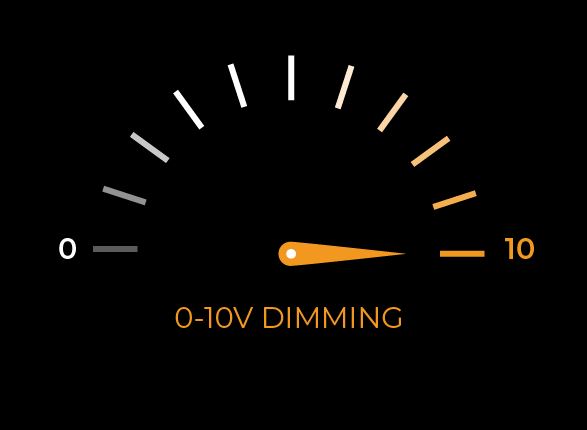Are you looking for a lighting system that makes managing, maintaining, and customizing your lights easier? 0-10v Dimming could be the perfect solution. This cleverly designed technology allows users to create unique light scenes tailored perfectly to their home or workplace space. But what is 0-10v Dimming, and how does it work? In this blog post, we’ll look at the intricacies of 0-10v Dimming and discuss its advantages over alternative dimmer systems. Together, we’ll discover why this dimmable lighting control may revolutionize how you illuminate your environment!

0-10v dimming
Introduce The Concept Of 0-10v Dimming.
Lighting is crucial in enhancing our daily lives and creating our desired ambiance. However, with the constant effort to save on energy consumption, we must ensure that our light fixtures are efficient and effective. This is where 0-10v dimming technology comes in. This concept refers to a lighting control method that uses an analog voltage signal to dim and brighten lights. The signal ranges from 0 to 10 volts, with 0 representing no output and 10 representing maximum output. The advantage of this technology lies in its ability to regulate light intensity precisely without altering the colors of the light source. It’s a simple way to create an energy-efficient and personalized home or workspace with as much or as little light as required at any given time.
Explain How 0-10v Dimming Works And How It Differs From Other Types Of Dimming Systems.
Have you ever wondered how lighting systems adjust brightness levels? The answer is dimming. Specifically, 0-10V dimming is a widely used technology that controls voltage levels to modify light intensity. Through a direct current signal, the voltage range varies between 0 volts and 10 volts to control light output. Compared to other types of Dimming, such as Pulse Width Modulation (PWM) or Digital Addressable Lighting Interface (DALI), 0-10V relies on analog control and is simpler to implement. Additionally, 0-10V dimming requires a dedicated control line, which makes it an ideal option for smaller lighting applications.
Detail The Advantages And Disadvantages Of 0-10v Dimming
Regarding lighting control, 0-10v Dimming has become popular due to its versatility and simplicity. One of the main advantages is its compatibility with a wide range of fixtures, making it easy to integrate into existing lighting systems. It also allows for smooth, continuous Dimming without any flickering or buzzing. However, there are some drawbacks to consider. One is that 0-10v Dimming requires additional wiring, which can increase installation costs.
Additionally, there may be better options for fixtures with low wattage, as it can result in an uneven dimming range. Overall, 0-10v Dimming can be a great solution for many lighting applications. Still, weighing the advantages and disadvantages is important to determine if it’s the right fit for your specific needs.
Identify The Types Of Lighting Fixtures That Are Compatible With 0-10v Dimming.
When setting the mood in a room, proper lighting is key. If you’re using a 0-10v dimming system, it’s important to know which lighting fixtures are compatible with this technology. Common fixtures working with 0-10v Dimming include LED fluorescent and HID lighting. By using compatible fixtures, you’ll have more control over the level of light in the room, making it easier to set the perfect ambiance for any occasion. So, next time you’re designing a lighting scheme, consider which fixtures will work with your 0-10v dimming system.
Highlight The Importance Of Using Compatible Components With 0-10v Dimming Systems For Optimal Performance.
When setting up a 0-10v dimming system, using compatible components is crucial for achieving optimal performance. These systems rely on a specific voltage range to regulate lighting levels, and any incompatible parts can cause unwanted fluctuations or damage the system. It’s important to do your research and find components that are designed to work together seamlessly. This will ensure that your system operates smoothly and contribute to your equipment’s longevity. Pay attention to the importance of using compatible components – it can make all the difference for your lighting setup.
Discuss Techniques To Troubleshoot Common Issues Related To 0-10v Dimming Systems
0-10v dimming systems are popular for controlling the lighting environment in various settings. However, it can be frustrating to figure out where to start when troubleshooting issues with these systems. One technique to identify common issues is to check the wiring connections. Poor connections or a loose connection amongst the wiring may cause problems with the 0-10v signal. Another technique is to check the dimming ballast or driver. A dimming ballast or driver that isn’t compatible with the bulb can cause flicker or no light output. Lastly, checking the programming of the system is essential. It’s essential to ensure that the input to the 0-10v controller is consistent with the programmed setting to avoid lighting inconsistency. Applying these techniques can build knowledge and ease the resolution process of common issues among 0-10v dimming systems.
In conclusion, 0-10v Dimming is a popular and effective type of dimming system due to its precise control of light output and color temperature. It converts a line-voltage signal to a 0-10v voltage range, producing a smooth and highly efficient operation. However, because the system requires compatible components, ensuring that all lighting fixtures and components used are certified and compatible for maximum performance is important. Installing the proper lamp holders can also reduce compatibility issues from incompatible components. Ultimately, understanding how 0-10v dimming works can be invaluable for any application requiring precise lighting control with superior results.


